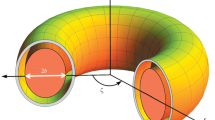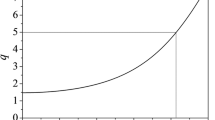Abstract
The influence of the Resistive Wall Mode (RWM) rotation on its stability in tokamaks is analyzed. Recently developed analytical theory [V. D. Pustovitov, Phys. Plasmas 19, 062503 (2012)] predicts that, when the skin depth s becomes much smaller than the wall thickness d w , the resistive dissipation in the wall in combination with the mode rotation stabilizes the mode up to complete suppression of instability. Here this effect is studied without the restriction on the ratio s/d w . Thereby the applicability of analytical predictions and accuracy of asymptotic expressions relating the growth rate to the rotation frequency of RWM is clarified. The dispersion relation for the rotating modes is derived in the single-mode cylindrical approximation and solved numerically. It is shown that the rotational stabilization of the plasma, the same as found earlier, is possible even at s/d w of the order unity if the mode rotation frequency is above a critical level. The dependences of the growth rate on the mode frequency are calculated for different plasma parameters. It is shown that, at a given plasma state with a linear response to external perturbations, the growth rate of the mode is maximal at the mode locking (when the rotation is lost). The relation of the mode minimal rotation frequency at the stability boundary with the growth rate at the mode locking is found. The analysis demonstrates strong influence of dissipation in the wall on the dynamics of rotating and locked RWMs and confirms the necessity to incorporate the skin effect into their description. The obtained estimates allow one to compare these predictions with experimental results.
Similar content being viewed by others
References
ITER Physics Expert Group on Disruptions, Plasma Control, and MHD and ITER Physics Basis Editors, Nucl. Fusion 39, 2251 (1999).
T. C. Hender, J. C. Wesley, J. Bialek, et al., Nucl. Fusion 47, S128 (2007).
G. Bateman, MHD Instabilities (MIT Press, Cambridge, MA, 1978).
J. P. Freidberg, Ideal Magnetohydrodynamics (Plenum, New York, 1987).
K. Miyamoto, Fundamentals of Plasma Physics and Controlled Fusion (Iwanami, Tokyo, 1997; Fizmatlit, Moscow, 2007).
M. S. Chu and M. Okabayashi, Plasma Phys. Controlled Fusion 52, 123001 (2010).
E. J. Strait, T. S. Taylor, A. D. Turnbull, et al., Phys. Rev. Lett. 74, 2483 (1995).
T. S. Taylor, E. J. Strait, L. Lao, et al., Phys. Plasmas 2, 2390 (1995).
A. M. Garofalo, A. D. Turnbull, M. E. Austin, et al., Phys. Rev. Lett. 82, 3811 (1999).
E. J. Strait, J. Bialek, N. Bogatu, et al., Nucl. Fusion 43, 430 (2003).
E. J. Strait, Fusion Sci. Technol. 48, 864 (2005).
A. M. Garofalo, Fusion Sci. Technol. 48, 918 (2005).
A. M. Garofalo, T. H. Jensen, and E. J. Strait, Phys. Plasmas 10, 4776 (2003).
S. Yu. Medvedev and V. D. Pustovitov, Plasma Phys. Rep. 29, 1009 (2003).
V. Igochine, Nucl. Fusion 52, 074010 (2012).
R. Betti and J. P. Freidberg, Phys. Rev. Lett. 74, 2949 (1995).
J. B. Taylor, J. W. Connor, C. G. Gimblett, et al., Phys. Plasmas 8, 4062 (2001).
M. S. Chu, V. S. Chan, M. S. Chance, et al., Nucl. Fusion 43, 196 (2003).
L. Frassinetti, P. R. Brunsell, and J. R. Drake, Nucl. Fusion 49, 075019 (2009).
V. D. Pustovitov, Phys. Plasmas 19, 062503 (2012).
V. D. Pustovitov, Plasma Phys. Rep. 39, 199 (2013).
P. C. de Vries, G. Waidmann, A. J. H. Donné, and F. C. Schüller, Plasma Phys. Controlled Fusion 38, 467 (1996).
I. H. Hutchinson, Plasma Phys. Controlled Fusion 43, 145 (2001).
S. C. Guo and M. S. Chu, Phys. Plasmas 9, 4685 (2002).
J. L. Luxon, M. J. Schaffer, G. L. Jackson, et al., Nucl. Fusion 43, 1813 (2003).
S. M. Wolfe, I. H. Hutchinson, R. S. Granetz, et al., Phys. Plasmas 12, 056110 (2005).
M. Cecconello, S. Menmuir, P. R. Brunsell, and M. Kuldkepp, Plasma Phys. Controlled Fusion 48, 1311 (2006).
P. Zanca, Plasma Phys. Controlled Fusion 51, 015006 (2009).
C. Paz-Soldan, M. I. Brookhart, C. C. Hegna, and C. B. Forest, Phys. Plasmas 19, 056104 (2012).
V. D. Pustovitov and V. V. Yanovskiy, Plasma Phys. Rep. 39, 345 (2013).
V. D. Pustovitov, Plasma Phys. Rep. 30, 187 (2004).
V. D. Pustovitov and M. S. Mayorova, Plasma Phys. Controlled Fusion 48, 51 (2006).
V. D. Pustovitov, Phys. Plasmas 14, 022501 (2007).
V. D. Pustovitov, Phys. Plasmas 14, 082506 (2007).
V. D. Pustovitov, Plasma Phys. Rep. 37, 35 (2011).
L.-J. Zheng and M. T. Kotschenreuther, Phys. Plasmas 12, 072504 (2005).
V. D. Pustovitov and V. V. Yanovskiy, Proceedings of the 34th EPS Conference on Plasma Physics, Warsaw, 2007, ECA 31F, P4.115 (2007); http://epsppd.epfl.ch/Warsaw/pdf/P4-115.pdf
V. D. Pustovitov, Phys. Lett. A 379, 2001 (2012).
V. D. Pustovitov, Plasma Phys. Rep. 38, 697 (2012).
H. Reimerdes, J. Bialek, M. S. Chance, et al., Nucl. Fusion 45, 368 (2005).
H. Reimerdes, T. C. Hender, S. A. Sabbagh, et al., Phys. Plasmas 13, 056107 (2006).
V. D. Pustovitov, Nucl. Fusion 47, 563 (2007).
V. D. Pustovitov, Plasma Phys. Rep. 34, 18 (2008).
Author information
Authors and Affiliations
Corresponding author
Additional information
Original Russian Text © V.D. Pustovitov, V.V. Yanovskiy, 2013, published in Fizika Plazmy, 2013, Vol. 39, No. 10, pp. 875–882.
The article was translated by the authors.
Rights and permissions
About this article
Cite this article
Pustovitov, V.D., Yanovskiy, V.V. Modeling of the rotational stabilization of tokamak plasmas with account of skin effect in the resistive wall. Plasma Phys. Rep. 39, 779–786 (2013). https://doi.org/10.1134/S1063780X13100097
Received:
Accepted:
Published:
Issue Date:
DOI: https://doi.org/10.1134/S1063780X13100097




